Airfix 1/48 Sea Hurricane Ib
The Fleet Air Arm suffered in the early years of the war for the lack of a carrier‑based fighter that had performance sufficient to face the land‑based Axis air forces on any basis of equality. This was nowhere more apparent than in the Mediterranean, where Axis air units were never more than an hour away from any Royal Navy units operating outside of land‑based fighter coverage from Gibraltar in the west or Alexandria in the east, and the Sea Gladiator and Fairey Fulmar fighters were so slow that they could only successfully intercept the speedy Italian S.M.79 Sparviero torpedo bombers of the Aerosiluranti if they were lucky enough to be positioned for a head-on attack, since the Italian bomber could outrun them. The German Ju-88 that would soon enter combat in the Mediterranean offered an even more-daunting challenge.
In 1941, the Air Ministry and the Admiralty decided to modify semi‑obsolescent Hawker Hurricane I fighters which had been superseded in Fighter Command to enable them to operate at sea. With its wide landing gear and relatively simple airframe, the Hurricane was the RAF fighter most capable of taking the stresses of carrier operations. After 60 were modified as Sea Hurricane Ia's for operation as catapult fighters, the Sea Hurricane Ib was created, with catapult spools and an A‑frame arrester hook. The Sea Hurricanes first saw action with 800 Squadron in May 1941, and its fame was made defending the Malta Convoys. Most unforgettable is the incredible story of the greatest Malta Convoy of all.
Operation Pedestal:
By July 1942, Malta had been under unrelenting attack by first the Regia Aeronautica and then the Luftwaffe for two years. Malta's strategic position was such that whoever controlled it would ultimately control the outcome of the war in North Africa. So important was Malta that in the spring of 1942, the Germans had considered mounting an airborne invasion.
For the British, resupplying Malta meant mounting major naval forces with as many capital ships as possible to escort the merchantmen, due to the proximity of the Italian Navy and the presence of German and Italian air units on Sicily less than 100 miles away from the shipping lanes, which put the convoys at incredible risk.
The first convoy was sent in September, 1941. Eight of the nine merchant ships survived attacks by the Regia Aeronautica to bring in 85,000 tons of supplies. In February, 1942, a convoy of three ships from Alexandria was unsuccessful, with the survivors turning back in the face of Axis opposition. A convoy sent from Gibraltar in March, 1942, consisted of three merchant ships and a Navy oiler, accompanied by four cruisers and sixteen destroyers, while a fifth cruiser and four destroyers sailed from Malta. The escort was successful in keeping the keeping the Italian battleship Vittorio Veneto, three cruisers and ten destroyers at bay. But the newly‑arrived Luftwaffe Fliegerkorps X struck the convoy south of Sicily, sinking one of the merchant ships only 20 miles from Malta, and sinking the oiler eight miles from Valetta Harbor. The two surviving ships made it into harbor only to be sunk before only a small fraction of their cargo could be unloaded.
It was imperative that another convoy be mounted. The most important element of the entire operation would be getting a tanker to Malta with gasoline and diesel fuel. The British had no tankers capable of maintaining the speed necessary to give the ship a fighting chance of making it through, and an appeal was made to Franklin Roosevelt that May. The tankers SS “Ohio” and SS “Kentucky” were sent to the British. At the time they were the largest and fastest tankers in the world. Launched April 20, 1940 at Sun Shipbuilding Yard in Chester, Pennsylvania, for the Texas Oil Company, “Ohio” and her sister ships were built in anticipation of war and were the result of unofficial conversations between the American military and the oil company. At 9,263 tons and 485 feet long, “Ohio” and her sister ships, “Oklahoma,” “Kentucky,” “Colorado,” “Montana,” “Georgia,” “Delaware,” and “Indiana” could each hold 170,000 barrels of oil. With 9,000 shaft horsepower Westinghouse turbine engines, they were rated at 16 knots. “Ohio” had managed 19 knots in sea trials.
In June, 1942, plans were made to use as many Royal Navy warships as could be scraped together to protect as large a convoy as could be organized, with ships coming from both Gibraltar and Alexandria. The Gibraltar convoy of six included the “Kentucky” and was escorted by a battleship, two aircraft carriers and four cruisers. The Alexandria convoy of eleven cargo ships was escorted by eight cruisers. The capital ships withdrew before the convoys reached the narrow seas between Sicily and North Africa, leaving support to the anti‑aircraft cruiser HMS “Cairo” and 13 destroyers. Under relentless attack from German and Italian dive bomber units, six ships were sunk, three were heavily damaged, and seven turned back. Only two ships arrived in Malta, and the “Kentucky” wasn't one of them. The convoy was a failure.
It was now time to do or die. If a convoy didn't get through to Malta by mid‑August, the island would run out supplies and be forced to surrender. What became known as “Operation Pedestal” was the largest Malta Convoy and would result in the biggest naval battle of the war in the Mediterranean.
Eighty ships, including fourteen cargo ships and the tanker “Ohio” were assembled. 64 Royal Navy warships including four aircraft carriers, were assigned. One carrier, HMS “Furious,” had the assignment of going ahead of the convoy and flying off Spitfires to Malta that could help provide air cover for the ships on their final run in to the island, when the escorting carriers would have to retire. This came on top of several successful runs to supply fighters to Malta in preceding months, including two by the carrier USS “Wasp.”
The largest fighter force in Fleet Air Arm history to that date was assembled aboard the three fleet carriers that would provide the heart of the escort. HMS “Eagle” carried the Sea Hurricanes of 801 and 813 Squadrons. HMS “Victorious” carried the Fulmars of 809 and 884 Squadrons and six Sea Hurricanes from 885 Squadron. The most experienced units were aboard HMS “Indomitable,” which included Sea Hurricanes of 800 Squadron led by FAA ace LCDR Bill Bruen, while “Butch” Judd led the Sea Hurricanes of 880 Squadron with Battle of Britain FAA ace “Dickie” Cork as his flight commander. 806 Squadron with Grumman Martlet IIs came aboard at the last minute.
The convoy left Gibraltar on August 10, 1942. It was expected to take four days for the ships to get to Malta, and that air attacks could be expected beginning on the second day. The convoy was almost immediately spotted by a French civilian flight from Algeria, and its report was picked up by the Germans, who now were ready. “Furious” made her high speed run‑in and launched 36 Spitfires at dawn on August 12.
On August 11, shortly after “Furious” departed, disaster struck when U‑73 sent four torpedoes into “Eagle.” Sinking within minutes, the carrier took 260 men and all the crucial Sea Hurricanes except the four flying combat air patrol, which landed aboard “Victorious” and became part of 885 Squadron.
At about the same time as “Furious” was launching her Spitfires on August 12, a Ju‑88 spotted the main convoy. Within two hours, the Sea Hurricanes, Fulmars and Martlets were in action against a total of 40 Ju‑88s, which they mostly managed to hold off. During the day's fighting, seven FAA pilots would “make ace,” one of whom was a sitting Member of Parliament, an indication of how hard‑fought the battle was. Over 100 German and Italian aircraft attacked during the day in six different raids, with the fighters claiming 28 destroyed and another 12 damaged, including five by Dickie Cork, the only FAA pilot during the war to become an “ace in a day.” (Editor's Note: According to Wiki, Cork was flying a IC variant, which had four cannon, at the time. IC delivery started in February 1942.) Two squadron commanders were lost. The fleet lost the cruisers “Cairo” and “Nigeria” torpedoed by Italian submarines, with “Cairo” abandoned. “Ohio” was torpedoed by an Italian submarine and her speed was reduced to 13 knots, forcing the entire convoy to slow. “Empire Hope,” one of several ships carrying aviation gasoline, had been bombed and set afire, and sunk by the escort. That night, as the convoy approached the Sicilian Narrows, “Victorious” and “Indomitable” and their escorts peeled off to return to Gibraltar.
The real battle now began. “Ohio” was the main target. The fleet passed through the minefields between Africa and Sicily at midnight. Shortly thereafter, eight Italian MTBs made 15 attacks, hitting the cruiser “Manchester” and the “Santa Elisa,” the other American ship in the convoy and the second ship carrying aviation gasoline, which was abandoned after she caught fire. Two British merchantmen were sunk, while the “Rochester Castle” was hit but kept going.
At 0400 fighters from Malta arrived overhead but were unable to blunt an attack by 20 Ju‑88s. The “Waimarana,” also carrying avgas, was hit and sunk. This attack was followed shortly by 60 Stukas, which focused on the “Ohio.” Near misses buckled her plates and the forward tanks filled with water. By 1050, her boilers were blown and she was dead in the water. The entire purpose of Operation Pedestal faced disaster.
The attacks continued throughout the day. The cruiser “Dorset” was hit by three near misses and abandoned when fire broke out. HMS “Kenya” narrowly avoided a similar fate when her crew was able to put out the fires in her forward engine room. The “Rochester Castle,” “Port Castle,” and “Melbourne Star” steamed on to meet escort from Malta and reached Grand Harbor in Valetta at 1800.
The plucky “Ohio” refused to sink. The destroyer HMS “Ledbury” came alongside to attempt a tow, but the ship wanted to move sideways. During the five hour attempt, a Ju‑88 ‑ hit by anti‑aircraft fire ‑ crashed onto the foredeck, while a Stuka that hit the water bounced, slammed into the tanker and exploded. After avoiding mines and torpedoes, “Ohio” was straddled by two bombs that lifted her out of the water as her keel was cracked. The crew abandoned ship in the expectation she would break in half.
On the morning of August 14, “Ohio” was still afloat, though the sea was washing over her main deck. A decision was made to attempt a second tow and two British destroyers moved in. Third Mate Frederick Larsen, Jr. and Francis Dales, Cadet‑Midshipman from the U.S. Merchant Marine Academy ‑ crew members from the sunken “Santa Elisa” who had been rescued by HMS “Ledbury” ‑ volunteered to board the “Ohio” and examine her as HMS “Ledbury” and a second destroyer, HMS “Penn,” prepared to lash themselves to either side of “Ohio” and bring her on to Malta. The destroyer HMS “Bramham” and minesweeper HMS “Rye” stood by to take forward tow.
After several hours this was accomplished. As the three ships began moving at a speed of 3 knots, with “Ohio” threatening at any minute to break apart, and with Stukas tipping over to attack, Larsen and Dales, accompanied by a British Gunner's Mate and three ratings, found a 20mm anti‑aircraft gun that was still operable aboard “Ohio.” All three ships at this point were under continuous dive bomber attack. Larsen took the trainer's position while Dale and the Gunner's Mate alternated as pointers. Over the course of the day they were responsible for shooting down four Stukas and damaging several others.
At the end of the day, a lucky German bomb went down “Ohio's” stack and blew out the bottom of the engine room. One more attack would sink the ship. Darkness intervened and the desperate tow continued throughout the night as “Bramham” and “Rye” prevented the Italian torpedo boats from approaching.
Dawn broke with Malta in sight. More attacks were made without success. At 0930 “Ohio” and her two British saviors entered the Grand Harbor. The Operation Pedestal convoy is known in Maltese history as "Il‑Konvoj ta Santa Marija" because it arrived on St. Mary's feast day.
Larsen and Dales received the Merchant Marine Distinguished Service Medal. The citation concluded, “The magnificent courage of this young third officer and cadet‑midshipman constitutes a degree of heroism which will be an enduring inspiration to seamen of the United States Merchant Marine everywhere.”
Operation Pedestal was the most important British naval victory in the Mediterranean. 400 Royal Navy sailors and merchant mariners gave their lives in the attempt. The Fleet Air Arm and the Malta air forces claimed 39 aircraft destroyed, and an Italian submarine sunk by the surface force.
“Ohio” took seven direct hits and twenty near misses, but was still able to deliver most of her original cargo of 12,000 tons of diesel fuel and aviation gasoline. Her captain, Dudley William Mason, was awarded the George Cross. After “Ohio” reached Malta, the ship broke in two from the damage she had sustained. There were insufficient shipyard facilities to repair her, so the two halves were used for storage, and later as barracks facilities for Yugoslav troops. On September 19, 1946, the two halves were towed ten miles off the coast, and sunk by naval gunfire. The aft section sank first, followed by the forward half.
By the end of September, 1942, the resupplied air forces on Malta were able to attack Axis convoys to North Africa so successfully that Rommel's supplies of gasoline and diesel fuel were cut in half. This had a direct on his defeat at El Alamein, which led to the expulsion of Axis forces from North Africa. Thus, the success of Operation Pedestal led to an entire change of Allied fortunes in the Mediterranean theater.
Airfix's recently-released Hurricane I kit includes some unadvertised “Easter eggs.” There are two lower rear fuselage sections, one of which is for a Sea Hurricane with provision for the A-frame arrestor hook. The hook assembly and the two catapult spools are also included. None of this is mentioned in the instructions, but there are no instructions needed to carry out the conversion. Thus, Airfix has released the only out-of-the-box Sea Hurricane kit (Hasegawa made two limited releases with a resin part containing the tail hook, a Sea Hurricane I and a Sea Hurricane IIc). Fortunately, Aeromaster released three Sea Hurricane decal sheets back in the late 1990s when the Hasegawa limited release Sea Hurricane came out, so decals are available for those who don't want to wait for Airfix to formally re-release the kit as a Sea Hurricane.
Construction of the Sea Hurricane proceeds exactly as for the regular Hurricane, except the two holes in the lower wing to either side of the radiator housing must be opened up to locate the catapult spools (parts D-41 and D-42). The lower rear fuselage section with the tail hook housing is used, as well as the tail hook (Part D-65). Voila! Say hello to your Sea Hurricane Ib!
I decided to do Sea Hurricane Ib V7077, which was originally assigned to 801 Squadron aboard “Eagle” but operated with 885 Squadron aboard “Victorious” after “Eagle” was sunk. The decals are available on Aeeromaster 48-439 “Sea Hurricanes at War - Part 1". The sheet is no longer in production but can be found for a reasonable price on eBay if you didn't buy it the first time around.
I used the profiles on the Aeromaster sheet to paint the model. I first painted the vertical fin and wing leading edges yellow and masked them off; this was a tactical marking for Operation Pedestal. The model was then painted in the FAA Temperate Sea Scheme of Dark SeaGrey, Dark Slate Grey and Sky, using Xtracrylix. I used Mal Mayfield's Miracle Mask for the upper surface camouflage scheme. After this was done, I unmasked the model and gave it an overall coat of Xtracrylix Gloss varnish. The decals went on without problem.
While I didn't have any photos of V7077, the fact the airplane had the new “C” scheme national markings applied gave me the clue it was a new Sea Hurricane conversion, so I did not “ding” the airframe. Photos of other Sea Hurricanes in Operation Pedestal show them well-maintained. I gave the model an overall coat of Xtracrylix Flat varnish, then attached the landing gear and prop, and unmasked the canopy and glued it in the open position.
Have I mentioned that the Airfix Hurricane I is the best Hurricane kit in any scale? Well, it is. It's also the best Sea Hurricane kit in any scale. Unfortunately, Airfix didn't make enough of them, so if you haven't bought one already, you are SOL until they finish a second production run. Should you run across one on eBay or a dealer's table or the back shelf of the LHS, grab it. It is a great kit and highly recommended.
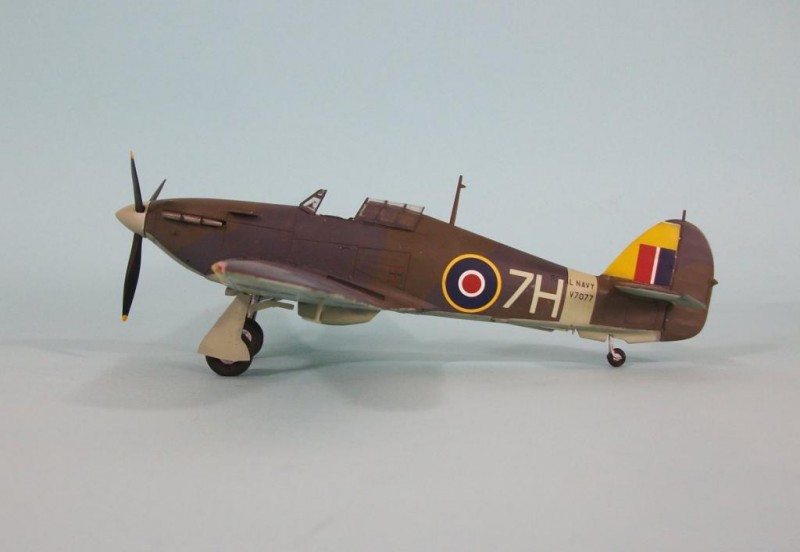
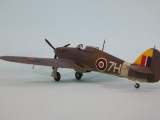
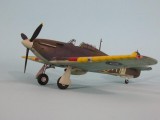
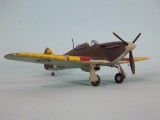
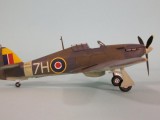
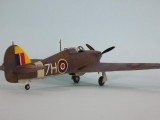
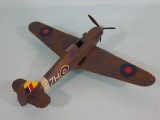
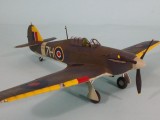
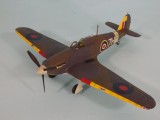
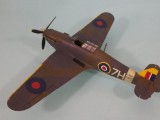
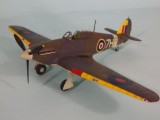
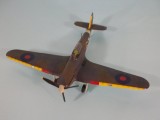
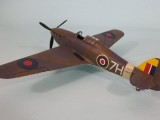
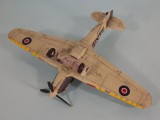
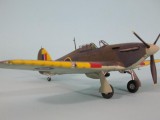

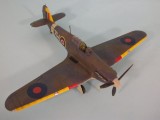
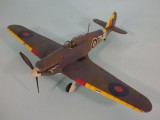
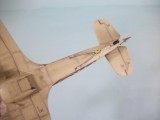
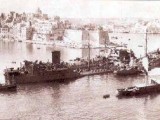
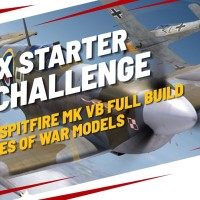
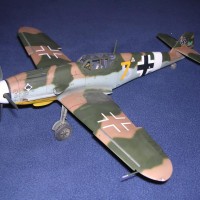
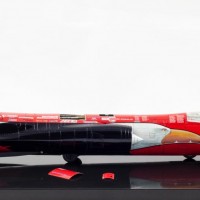
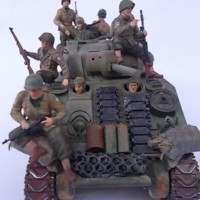
Great looking Hurricane Tom, and some great history to boot. What do you use to mask your canopies? I find it hard to beat Tamiya tape, but am always looking for new ideas.
Tamiya tape, a new #11 blade, and patience.
Same here, although I've used two sets of the EZ masks so far. They work pretty good and save a lot time (that seems to matter more and more as I get older :)).
I'll use EZ masks whenever I can get 'em. the big time saver here was Mal Mayfield's Miracle Mask for the camo scheme. Take care of them and they can be used indefinitely (a good thing if you're a Hurricane prop, er, I mean Fan).
Gone already, not surprising. Or as we say here in the colonies, Rats!
I talked to the HornbyUSA rep I deal with for review kits, and she told me Airfix is only starting to realize how good their new stuff is. They're still making marketing decisions on what people used to say about them.
Nice back story and easily one of my favourite aircraft (as I've mentioned here every time one is posted!).
Like nice build in RN colors..
P.k
Fun color scheme for this iconic aircraft! Nice build - and as always, great bit of history lesson.
As usual a fine model Thomas. Airfix has really got their S--- together. Just a matter of time for a proper 1/48 P-40B? Or dare I dream 1/32? BTW, Pedestal is one of the GREAT stories of WW2, and very under-written. Maybe an accomplished author should step in and do the definitive book?
Fine work Tom, sounds like this kit may be the answer we've been waiting for. Did you use the kit canopy ?
Yes, but I used the 'closed" option because the "open" option fits too loosely and doesn't look right. the "closed" option fits close without problems.
Great job on the Sea-'Cane, hope Airfix start pumping them out, been keeping an eye out at the local HS, no luck so far, even scarce online. What a story! Not enough written about that theatre of the war.
Very informative and a great looking model.
A very nice Hurricane !